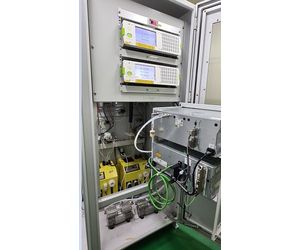

- Home
- Companies
- ECO Physics AG
- Articles
- SK Gas Power Plant in Ulsan, Korea and ...

SK Gas Power Plant in Ulsan, Korea and the implementation of ECO PHYSICS analyzers - Case Study
The SK Gas power plant in Ulsan, South Korea, represents a significant milestone in the energy sector, marking the world`s first gigawatt-class LNG and LPG combined cycle power plant. Launched on December 26, 2024, the Ulsan GPS (Gas Power Solution) facility boasts a generation capacity of 1.2 GW, equivalent to that of a single nuclear power plant. This innovative power plant, constructed with an investment of 1.4 trillion won (approximately $954.7 million), has the capacity to supply electricity to 2.8 million households annually.
Unique features and flexibility
The Ulsan GPS stands out for its dual-fuel capability, primarily using LNG but with the option to switch to LPG depending on market conditions. This flexibility enhances the plant`s operational stability and resilience to fluctuating energy markets. The facility plans to consume 900,000 to 1 million tons of LNG annually, supplied by the nearby Korea Energy Terminal (KET)
Environmental considerations
While the Ulsan GPS represents a significant advancement in power generation, it`s crucial to consider the environmental impact of such facilities, particularly in terms of nitrogen oxide (NOx) emissions. NOx is a significant air pollutant produced during combustion processes, including those in power plants.
The importance of measuring NOx-emissions
- Regulatory Compliance: NOx emissions are increasingly regulated worldwide, including in South Korea. Accurate measurement ensures compliance with relevant directives and environmental standards.
- Health impact: NOx contributes to the formation of particulate matter and smog, which can have severe health consequences, including respiratory and cardiovascular diseases. Monitoring NOx levels helps assess potential health risks to the surrounding population.
- Environmental protection: NOx emissions contribute to acid rain and other environmental issues. Measuring these emissions is crucial for understanding and mitigating their impact on ecosystems.
- Operational efficiency: NOx measurements can indicate combustion efficiency and help optimize plant operations, potentially leading to reduced fuel consumption and lower emissions.
- Economic activity indicator: Interestingly, NOx levels can serve as an indicator of economic activity, providing insights into industrial operations and energy consumption patterns.
- Technological advancement: The need for NOx measurement drives innovation in monitoring technologies and emissions control systems, contributing to the overall advancement of cleaner energy production.
- Policy formulation: Accurate NOx emission data is essential for policymakers to make informed decisions about energy policies, environmental regulations, and public health measures.
In the context of South Korea, where air quality has been a significant concern, the measurement and control of NOx emissions from power plants like Ulsan GPS are particularly crucial. The country has been updating its emission control standards under the Clean Air Conservation Act, aiming to reduce air pollution and its associated health impacts.
ECO PHYSICS’ nCLD EL including NO2 toggle valve
After passing successfully the demanded standards of the Korean environmental authority, Various SK power plants, including the one in Ulsan, ECO PHYSICS’ nCLD EL became part of the standard equipment to monitor the NO and NO2 emissions. The ECO PHYSICS nCLD EL analyzer is a single-chamber chemiluminescence detector designed for precise NO/NOx measurements in the range of 0.5-500 ppm. It features a metal or steel converter for NOx detection and incorporates a toggle valve system for NO2 measurement. This valve alternately bypasses and sends sample air through a heated NO2 scrubber every 5 seconds, allowing the instrument to measure light intensity with and without NO2 present. This alternating measurement enables the calculation of NO2 concentration using the Beer-Lambert Law. The analyzer offers four freely selectable measuring ranges, a minimum detectable concentration of 0.05 ppm, and a response time of less than 3 seconds.
Conclusion
The Ulsan GPS represents a significant advancement in power generation technology, offering operational flexibility and high capacity. However, its environmental impact, particularly in terms of NOx emissions, must be carefully monitored and managed. The importance of measuring NOx emissions extends beyond mere regulatory compliance, encompassing public health, environmental protection, and economic considerations. As South Korea continues to balance its energy needs with environmental concerns, facilities like Ulsan GPS will play a crucial role in shaping the country`s energy future, with NOx emission measurement serving as a key tool in ensuring sustainable and responsible operation.

